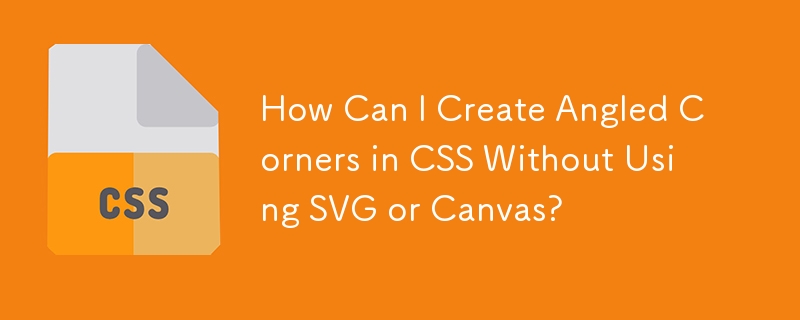How Can I Create Angled Corners in CSS Without Using SVG or Canvas?

Angled Corners in CSS: A Cutting-Edge Technique
Designing an aesthetically pleasing website can be challenging, especially when it comes to creating angled corners. However, with the advancements in CSS, it's now possible to achieve this effect without resorting to non-native methods like SVG or canvas.
Creating the Angled Corner
To create an angled corner, we can leverage the :before and :after pseudo-elements along with a parent container. By manipulating the position, border styles, and offsets of these elements, we can effectively block out a corner while preserving the border.
Step 1: Container Border
Begin by adding a border to the container element to define the outer boundaries of our angled corner.
Step 2: :before Pseudo-Element
Next, add the :before pseudo-element to cut off the desired corner. Position it absolutely, with a negative offset of -1px to cover the border. Apply a solid border to the top and a transparent border to the right to create the slanted line.
Step 3: :after Pseudo-Element
To create the line inside the cut-off, add the :after pseudo-element with a slightly smaller offset of -2px. Give it a solid white border to the top and a transparent border to the right.
Example Implementation
The following CSS code demonstrates how to apply these principles:
.cutCorner {
position:relative; background-color:blue;
border:1px solid silver; display: inline-block;
}
.cutCorner img {
display:block;
}
.cutCorner:before {
position:absolute; left:-1px; top:-1px; content:'';
border-top: 70px solid silver;
border-right: 70px solid transparent;
}
.cutCorner:after {
position:absolute; left:-2px; top:-2px; content:'';
border-top: 70px solid white;
border-right: 70px solid transparent;
}This code can be used to wrap an image element within a container, resulting in an image with the specified angled corner.
Alternative Approach
While CSS techniques can provide a solution, if precise control over the angled corner is required or additional features like masking or image clipping are desired, using SVG or canvas may be a more suitable approach.
The above is the detailed content of How Can I Create Angled Corners in CSS Without Using SVG or Canvas?. For more information, please follow other related articles on the PHP Chinese website!

Hot AI Tools

Undresser.AI Undress
AI-powered app for creating realistic nude photos

AI Clothes Remover
Online AI tool for removing clothes from photos.

Undress AI Tool
Undress images for free

Clothoff.io
AI clothes remover

Video Face Swap
Swap faces in any video effortlessly with our completely free AI face swap tool!

Hot Article

Hot Tools

Notepad++7.3.1
Easy-to-use and free code editor

SublimeText3 Chinese version
Chinese version, very easy to use

Zend Studio 13.0.1
Powerful PHP integrated development environment

Dreamweaver CS6
Visual web development tools

SublimeText3 Mac version
God-level code editing software (SublimeText3)

Hot Topics
 1657
1657
 14
14
 1415
1415
 52
52
 1309
1309
 25
25
 1257
1257
 29
29
 1230
1230
 24
24
 Google Fonts Variable Fonts
Apr 09, 2025 am 10:42 AM
Google Fonts Variable Fonts
Apr 09, 2025 am 10:42 AM
I see Google Fonts rolled out a new design (Tweet). Compared to the last big redesign, this feels much more iterative. I can barely tell the difference
 How to Create an Animated Countdown Timer With HTML, CSS and JavaScript
Apr 11, 2025 am 11:29 AM
How to Create an Animated Countdown Timer With HTML, CSS and JavaScript
Apr 11, 2025 am 11:29 AM
Have you ever needed a countdown timer on a project? For something like that, it might be natural to reach for a plugin, but it’s actually a lot more
 HTML Data Attributes Guide
Apr 11, 2025 am 11:50 AM
HTML Data Attributes Guide
Apr 11, 2025 am 11:50 AM
Everything you ever wanted to know about data attributes in HTML, CSS, and JavaScript.
 How We Created a Static Site That Generates Tartan Patterns in SVG
Apr 09, 2025 am 11:29 AM
How We Created a Static Site That Generates Tartan Patterns in SVG
Apr 09, 2025 am 11:29 AM
Tartan is a patterned cloth that’s typically associated with Scotland, particularly their fashionable kilts. On tartanify.com, we gathered over 5,000 tartan
 A Proof of Concept for Making Sass Faster
Apr 16, 2025 am 10:38 AM
A Proof of Concept for Making Sass Faster
Apr 16, 2025 am 10:38 AM
At the start of a new project, Sass compilation happens in the blink of an eye. This feels great, especially when it’s paired with Browsersync, which reloads
 How to Build Vue Components in a WordPress Theme
Apr 11, 2025 am 11:03 AM
How to Build Vue Components in a WordPress Theme
Apr 11, 2025 am 11:03 AM
The inline-template directive allows us to build rich Vue components as a progressive enhancement over existing WordPress markup.
 PHP is A-OK for Templating
Apr 11, 2025 am 11:04 AM
PHP is A-OK for Templating
Apr 11, 2025 am 11:04 AM
PHP templating often gets a bad rap for facilitating subpar code — but that doesn't have to be the case. Let’s look at how PHP projects can enforce a basic
 Programming Sass to Create Accessible Color Combinations
Apr 09, 2025 am 11:30 AM
Programming Sass to Create Accessible Color Combinations
Apr 09, 2025 am 11:30 AM
We are always looking to make the web more accessible. Color contrast is just math, so Sass can help cover edge cases that designers might have missed.




